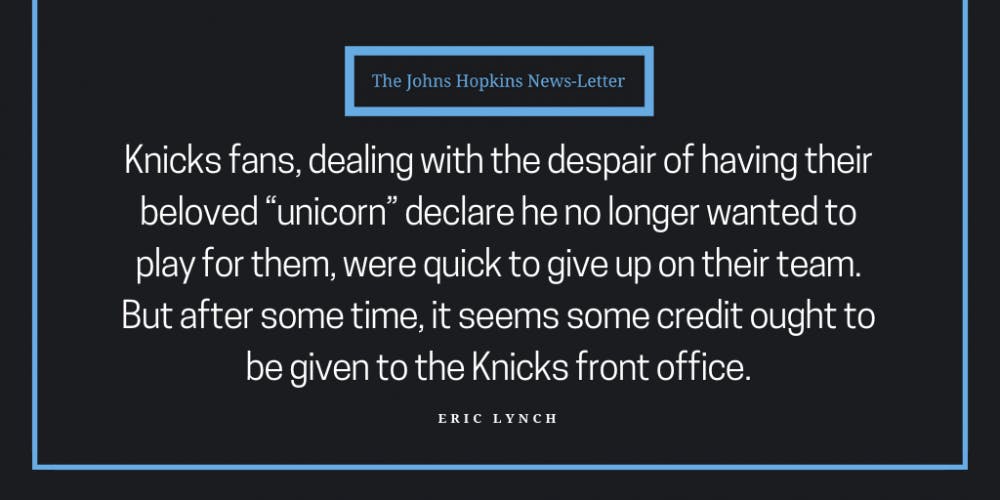
Jan. 31 started like a normal day for New York Knicks fans. But about halfway through the day, news broke that their beloved star, Kristaps Porziņģis, was unhappy with the team and wanted to be traded. After approximately one hour of panic and speculation, Porziņģis was dealt to the Dallas Mavericks in a deal that involved seven players and two draft picks.
After initial feelings of anger and shock from Knicks fans as well as hope and excitement from Mavericks fans, people began stepping back and looking at the trade from a more objective perspective. The Mavericks received Porziņģis, Tim Hardaway Jr., Courtney Lee and Trey Burke. The Knicks received DeAndre Jordan, Dennis Smith Jr., Wesley Matthews and two future first-round draft picks.
At first, many were quick to say that the Mavericks had clearly won this trade. After all, they received a borderline All-Star without having to give one up. A closer look seems to confirm that Dallas got a lot of value out of this trade.
The Mavericks are not necessarily in a win-now position, but they are certainly setting themselves up to make deep playoff runs in the near future. After drafting arguably the most exciting rookie in years, Luka Dončić, they are looking to surround him with a young core that can develop alongside him.
Porziņģis fills this role perfectly. Both were European superstars who already have a history together. Porziņģis is 23 years old while Dončić is 19. For comparison, DeAndre Jordan and Wesley Matthews were 30 and 32, respectively.
Also, Porziņģis joins the team just in time to watch future Hall of Famer Dirk Nowitzki in his final season with the team. Porziņģis, being a European seven-footer with a good three-point shot, has drawn non-stop comparisons to Nowitzki and will certainly benefit from his presence.
Tim Hardaway Jr. was dealt simply to get rid of his horrendously high salary. The number one option for the Knicks while Porziņģis was out, Hardaway may provide some scoring for the Mavericks, but he was really only included in this deal to free up cap space for the Knicks.
Courtney Lee will be a good veteran presence for Dončić and can still serve as a good role player for the team. The last piece of the deal, Trey Burke, is a young player who found a career revival with the Knicks. He can score well at times, but his production will depend on how Mavericks coach Rick Carlisle decides to use him.
If it isn’t already clear, the main purpose of this trade for the Mavericks was to get Porziņģis. The other players included won’t be a detriment to the team, but their production won’t decide who won this deal. If Porziņģis comes back from his injury at the same level he was playing before, the Mavericks will have already gotten great value out of this trade.
Knicks fans, dealing with the despair of having their beloved “unicorn” declare he no longer wanted to play for them, were quick to give up on their team. But after some time, it seems some credit ought to be given to the Knicks front office.
The Knicks were 10-40 at the time of the trade and had not won a game since Jan. 4, so they were already in full tank mode. Many fans were hoping to get the number one overall pick and draft Duke University star Zion Williamson. The two first-round picks from Dallas can only help them with their rebuild. Depending on where these picks end up falling and what prospects are available, they have the potential to be the most valuable parts of this trade.
However, the more immediately appealing piece of this deal is Dennis Smith Jr., whom the Knicks hope will develop alongside fan-favorite rookies Kevin Knox, Mitchell Robinson and Allonzo Trier. Smith has shown promise, and if he develops well, he can certainly help the Knicks escape their cycle of mediocrity.
Rumors of buyouts are already spreading around the aging veterans — Matthews and Jordan — so the production they can still provide may not be used with the Knicks for very long.
This is one of those trades that definitely helps both sides. In its simplest form, the Knicks traded Kristaps Porziņģis for Dennis Smith Jr. and two first-round draft picks. The Mavericks got an incredibly valuable asset to fit their win-soon timeline, while the Knicks got three variably valuable assets to fit their full rebuild timeline.
It’s essentially impossible to tell who won this trade at the moment. There are three factors that will determine the winner when all is said and done: Porziņģis’ recovery, Smith’s development and who the Knicks draft with the two picks.
If all of those things work out, both teams are winners. If Porziņģis cannot replicate his former level of play, nothing else really matters and the Mavericks would have lost this trade.
The Knicks have a much more nuanced set of circumstances ahead of them. They traded away a disgruntled star, an overpaid guard, a veteran who didn’t play and a scorer who may have hit his peak already. Those are all non-valuable assets. Because the Knicks got rid of all of them in one trade and got anything of value in reurn, they are already winners.
But to get as much value as possible out of this deal, the Knicks have to draft well. Even if Smith becomes the player some think he can be, bad drafting could still damage this trade’s reputation. Given Porziņģis’ trade request, the Knicks really did the best they could, and they are now in full control of their future.





